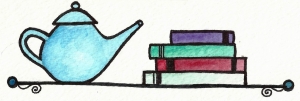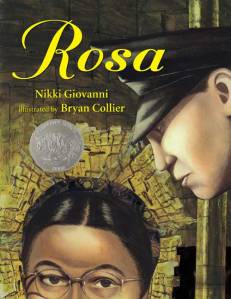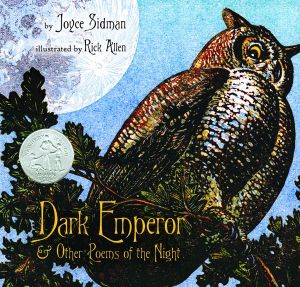A special, ultra-vibesy shout-out to Novel Niche’s official illustrator (and my dear friend), writer and artist Danielle Boodoo-Fortuné, whose newly-commissioned artwork for NN filled me with a burst of creative zeal, inspiring me to relaunch this particular series. Thank you, Danielle! 🙂 *showers you with leaves*

Rosa, written by Nikki Giovanni, illustrated by Bryan Collier. Published in 2005 by Henry Holt and Company.
This story first came to me in my mid-twenties.
 It’s December 1st, 1955. After a day of work at her seamstress’ job in Montgomery, Alabama, Rosa Parks boards a city bus from its hateful Coloureds entrance, and takes a seat in the vehicle’s neutral section, where both blacks and whites can sit. Looking forward to returning home and cooking her husband something special, Parks’ positive daydreaming is interrupted by the bus driver’s belligerent demands that she surrender her seat to a white passenger. As anyone with a smidgeon of knowledge on the African-American Civil Rights Movement will tell you, Rosa Parks refused – not with equal hostility, but with a calm, undaunted resolve that has etched her name into history books, monuments and national holidays. Giovanni’s faithful, poetic retelling of Parks’ story takes the reader onto that very bus, and beyond it, to the Montgomery Bus Boycott that her actions springboarded into life. It includes the nomination of Martin Luther King, Jr. as the official spokesperson for anti-segregation laws, sparking a nonviolent movement towards equality in the Constitution of the United States.
It’s December 1st, 1955. After a day of work at her seamstress’ job in Montgomery, Alabama, Rosa Parks boards a city bus from its hateful Coloureds entrance, and takes a seat in the vehicle’s neutral section, where both blacks and whites can sit. Looking forward to returning home and cooking her husband something special, Parks’ positive daydreaming is interrupted by the bus driver’s belligerent demands that she surrender her seat to a white passenger. As anyone with a smidgeon of knowledge on the African-American Civil Rights Movement will tell you, Rosa Parks refused – not with equal hostility, but with a calm, undaunted resolve that has etched her name into history books, monuments and national holidays. Giovanni’s faithful, poetic retelling of Parks’ story takes the reader onto that very bus, and beyond it, to the Montgomery Bus Boycott that her actions springboarded into life. It includes the nomination of Martin Luther King, Jr. as the official spokesperson for anti-segregation laws, sparking a nonviolent movement towards equality in the Constitution of the United States.
What enchanted me?
Rosa Parks’ story isn’t, or shouldn’t be, new to most adults with any cognizance of the struggle against segregation in the U.S., but it might be in danger of being forgotten, if the story ever ceases to be told. This feels like a difficult concept for me to swallow, but several conversations with young people have assured me, repeatedly, of how easy it is to forget — and I balk to think at all the truthful, useful things I myself have forgotten.
Giovanni frames this true encounter with racism’s snarling maw in a way that glides effortlessly off the page. She fills up the narrative with impressions of Rosa as she was: calm, grounded, honest about her motivations in refusing unfair treatment: not because she was physically tired, but because she was exhausted of being trampled by an unfair hierarchy. Books such as these are a boon to young readers, who interface with history’s heroines and heroes, as well as to the adults who read them aloud. For adults, they act as pillars of printed remembrance, of real stories that ought never be forgotten.
A 2006 Caldecott Honor Book, Rosa is beautifully illustrated in watercolour images and collage treatments by Bryan Collier, creating warm and immersive effects. His pictoral imaginings of the life that Parks led, up til and beyond her powerful act of resistance, complement Giovanni’s clear, strong prose. Collier received the 2006 Coretta Scott King Book Illustrator Award for his work in Rosa.
Lines for Life:
“She sighed as she realized she was tired. Not tired from work but tired of putting white people first. Tired of stepping off sidewalks to let white people pass, tired of eating at separate lunch counters and learning at separate schools. […] She thought about her mother and her grandmother and knew they would want her to be strong. She had not sought this moment, but she was ready for it.”
This book would be best-beloved by:
♣ An avid junior historian who’s curious about investigating the past, and not hesitant to name pioneers for social justice as her role models, in lieu of pop stars.

Dark Emperor & Other Poems of the Night, written by Joyce Sidman, illustrated by Rick Allen. Published in 2010 by Houghton Mifflin Books for Children.
I was in my mid twenties when these poems fell into my palms.
 This collection begins with a nocturnally winsome invocation, “Welcome to the Night”, in which these dark hours are described with as much liveliness and imaginative engagement as any merry daylight revel:
This collection begins with a nocturnally winsome invocation, “Welcome to the Night”, in which these dark hours are described with as much liveliness and imaginative engagement as any merry daylight revel:
“The night’s a sea of dappled dark,
the night’s a feast of sound and spark,
the night’s a wild, enchanted park,
Welcome to the night!”
Subsequent poems are dedicated to specific woodland creatures: snails; moths; owls; trees; spiders; porcupettes; crickets; mushrooms; efts; bats, and the moon. Each poem reveals the ways in which these night companions investigate and explore their domain, during the hours between evening’s first footfall and the dawn’s pearly herald of a new day. For every poem, too, there is a column of accompanying factual text, detailing the physical properties, habits and characteristics of the poem’s subject.
What enchanted me?
A 2011 Newberry Honor Book, Dark Emperor is precisely the sort of children’s book that will be read to Baby/ies Novel Niche, should one/s ever be bouncily forthcoming. Barring that possibility, however, this remains a book for both treasuring closely and sharing widely, which is why I’ve two copies and plans to acquire more. Sidman’s poems are laden with the prancings, rustlings and winkings of these sylvan inhabitants, and each piece is a resonant embodiment of its focus. In “Dark Emperor”, from which the book derives its title, Sidman hones in unerringly on the great horned owl’s imperious majesty, wondering in verse at
“What symphonies of
squeaks and skitters, darts
and rustles, swell the vast,
breathing darkness of your realm?”
The owl as foreboding predator; the spider as confident peddler of survival instincts; the steadfast and nurturing guardianship of the oak tree: these character sketches and several others await the reader, bound to fascinate children with any love for the earth’s wild and unexplored places. The factual supplements will interest older children who are getting their hands and chemistry sets messy with documenting their environmental observations.
Rick Allen’s relief printed lino cuts are individual vistas of panoramic and precise astonishment, allowing a revisitation of familiar animals and haunts with eyes that will appreciate the artist’s intricacy, his use of shadow and light, his measured and brilliant application of pigment. Allen’s art holds hands eagerly and elegantly with Sidman’s, and the results are worth reading and rereading: they make the perfect invitation to a night-time slumber party of imaginative revels, beneath the glow of a moon waxing towards fullness.
Lines for Life:
“Where are the diving sweeps of the nighthawk
and where its haunting cry?
Where is the thrum of crickets,
the throbbing of frogs?
Where are the great flocks of travelers
whose soft wings whispered to me,
wave upon wave,
beating toward some distant wood?”
from “The Moon’s Lament” (an ubi sunt)
This book would be best-beloved by:
♣ A wee expeditioner with good, clean dirt beneath his fingernails, a magnifying glass hanging from a string ’round his neck, and a heart filled with investigative zeal that tracks muddy footprints right into the night forest’s teeming core.

Charting Children’s Literature is a monthly feature at Novel Niche that seeks to highlight the beauty and richness inherent in many of the books written and illustrated with the enjoyment and education of young children in mind. The feature was launched in August 2011, and is set to run for the foreseeable future (to infinity and beyond)!
If you’re interested in bringing to my attention beautiful children’s books I haven’t yet covered, feel free to leave a comment on this page. If you would like to contribute a guest Charting Children’s Literature feature, please make use of the contact form provided. I’m looking forward to hearing from you!

 Mama’s Saris, written by Pooja Makhijani, illustrated by Elena Gomez. Published in 2007 by
Mama’s Saris, written by Pooja Makhijani, illustrated by Elena Gomez. Published in 2007 by  A young girl wants to celebrate her seventh birthday party in the finest style possible, and for her, this means the right to wear one of her mother’s intricate saris. As her mother produces the infrequently worn, much-treasured collection from its storage space beneath the bed, her daughter pleads, cajoles and sulks, seemingly to no avail. Each sari the mother holds up from the leather suitcase has its own story. The one she selects for herself to wear at her child’s birthday celebration is brilliantly orange, trimmed with a carmine hem, and it was also donned on the day she brought her infant daughter home for the first time. Others, in colours of ripe fruit; the ink-dark midnight sky; the wide, blue ocean, are paraded before the daughter, and finally, sensing the young girl’s urgency, the mother comes to a momentous decision that will frame the day in heightened significance for them both.
A young girl wants to celebrate her seventh birthday party in the finest style possible, and for her, this means the right to wear one of her mother’s intricate saris. As her mother produces the infrequently worn, much-treasured collection from its storage space beneath the bed, her daughter pleads, cajoles and sulks, seemingly to no avail. Each sari the mother holds up from the leather suitcase has its own story. The one she selects for herself to wear at her child’s birthday celebration is brilliantly orange, trimmed with a carmine hem, and it was also donned on the day she brought her infant daughter home for the first time. Others, in colours of ripe fruit; the ink-dark midnight sky; the wide, blue ocean, are paraded before the daughter, and finally, sensing the young girl’s urgency, the mother comes to a momentous decision that will frame the day in heightened significance for them both. Owl At Home, written and illustrated by Arnold Lobel. Published in 1975 by
Owl At Home, written and illustrated by Arnold Lobel. Published in 1975 by  Owl At Home is an offering of five short tales in the life of Owl, an affable, thoughtful gentle-bird who seems to delight in his own company, as well as in exploring the world around him. In “The Guest”, Owl learns that some visitors simply won’t adhere to expected protocol, when he invites Winter past his threshold on a particularly chilly night. “Strange Bumps” tells the story of Owl’s fear of two mysterious lumps that appear near the foot of his bed when he lies down, and how he deals with their persistent recurrence. A kettle full of weeping, prompted by ruminations on the saddest things, such as forgotten pencil stubs and never-seen sunrises, fills the kettle for Owl’s delicious, albeit slightly salty, “Tear-Water Tea”. “Upstairs and Downstairs” reveals Owl’s frustration over his inability to exist both on the landing as well as at the foot of his twenty-stepped staircase. Finally, in “Owl and the Moon”, our avian friend finds that a contemplation of the moon near the seaside doesn’t necessarily end when he folds his wings and prepares to head home.
Owl At Home is an offering of five short tales in the life of Owl, an affable, thoughtful gentle-bird who seems to delight in his own company, as well as in exploring the world around him. In “The Guest”, Owl learns that some visitors simply won’t adhere to expected protocol, when he invites Winter past his threshold on a particularly chilly night. “Strange Bumps” tells the story of Owl’s fear of two mysterious lumps that appear near the foot of his bed when he lies down, and how he deals with their persistent recurrence. A kettle full of weeping, prompted by ruminations on the saddest things, such as forgotten pencil stubs and never-seen sunrises, fills the kettle for Owl’s delicious, albeit slightly salty, “Tear-Water Tea”. “Upstairs and Downstairs” reveals Owl’s frustration over his inability to exist both on the landing as well as at the foot of his twenty-stepped staircase. Finally, in “Owl and the Moon”, our avian friend finds that a contemplation of the moon near the seaside doesn’t necessarily end when he folds his wings and prepares to head home. This tale first came to me at the age of 15 or so.
This tale first came to me at the age of 15 or so. I first opened these pages when I was in my early twenties.
I first opened these pages when I was in my early twenties. The Maiden on the Moor, written by Marilyn Singer, illustrated by Troy Howell. Published in 1995 by Morrow Junior Books, New York (an imprint of
The Maiden on the Moor, written by Marilyn Singer, illustrated by Troy Howell. Published in 1995 by Morrow Junior Books, New York (an imprint of  This tale first came to me at the age of 21 or so.
This tale first came to me at the age of 21 or so. I first opened these pages when I was 5 or 6.
I first opened these pages when I was 5 or 6.